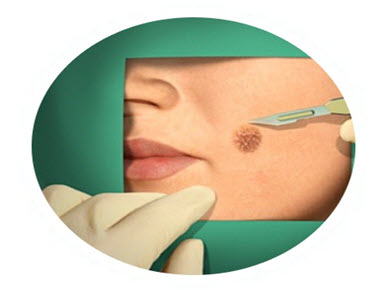Skin cancer
In the Netherlands, skin cancer is the most common form of cancer. There are different forms of skin cancer. Basal cell carcinoma is by far the most common, followed by squamous cell carcinoma and melanoma.
About 1 in six Dutch people develop one or more skin cancers during their lifetime. Basal cell carcinoma arises in the top layer of the skin and exposure to the sun is the main cause. Think of sunburns and a continuous excessively high sun exposure. This causes irreparable damage to cells in the skin, which can cause skin cancer.
Very often, skin cancer can be treated well with skin cancer surgery. Facial skin cancer treatment is often done through Mohs surgery.
Basal cell carcinoma
The basal cell carcinoma can look in different ways. In “nodular” basal cell carcinoma, there is often a skin-colored to pink glossy bump or elevation, which slowly enlarges. The “spiny” basal cell carcinoma, on the other hand, can often be difficult to distinguish from normal skin, is often flatter and can give subtle changes to the skin, such as radiance and altered appearance. Usually, a basal cell carcinoma does not cause any symptoms for the first few years. It may well present itself as a wound that will not heal or a spot that bleeds easily. If there is a suspicion of skin cancer, it is important to see a doctor.
Facial skin cancer treatment
The most effective facial skin cancer treatment is cutting it out. The smaller and simpler basal cell carcinomas are removed with a normal excision. That means cutting the lesion. A rim of healthy skin is also included to have the skin cancer completely removed. The wound is immediately closed. The lesion that has been removed will be sent for further examination to see if it has been completely removed. You will usually receive the results after 2 weeks.
Mohs surgery is performed for basal cell carcinomas on the face that are larger, in a difficult location or with an aggressive growth habit. You do not want to remove too much healthy tissue as a margin, you want to be sure that the cut edges are clean of cancer and you want to know this before the wound is closed.
Mohs surgery is reimbursed by the health insurer if a number of conditions are met. These include basal cell carcinomas on the nose and around the eyes and ears (called the H-zone). Beyond that, it is the somewhat larger tumors, often with a more aggressive growth habit in the face. A recurrence (a basal cell carcinoma that has come back in the same place after previous treatment and basal cell carcinomas that were not completely removed during a previous excision, are also treated with Mohs surgery.
Mohs surgery at the Roosevelt clinic
In the Roosevelt clinic, both forms of surgeryof facial skin cancer treatment are performed. Both treatments are performed on an outpatient basis under local anaesthetic. In Mohs surgery, the skin cancer is removed in a special way so that the cut edges can be fully assessed. The wound is temporarily bandaged. The patient will now wait. The extracted tissue is frozen and then sliced. These are assessed under the microscope to see if there is still tumor in the cut edges. If this is the case, extra tissue is removed where it is needed. This continues until everything is removed. The wound is then closed by suturing the wound edges together, by means of a skin graft or with the aid of a skin plastic. More information about how the Mohs treatment works and a patient brochure can be found on this page .
The skin cancer treatments in the Roosevelt clinic are performed by dermatologists, medical specialists of the skin, who are specialized in the field of skin cancer and skin cancer surgery. The Roosevelt clinic is associated with the skin cancer center of the LUMC.
